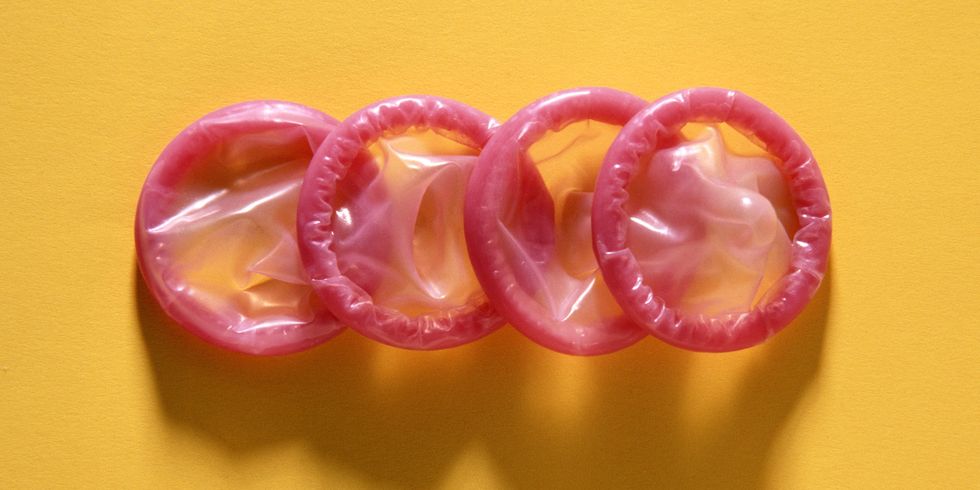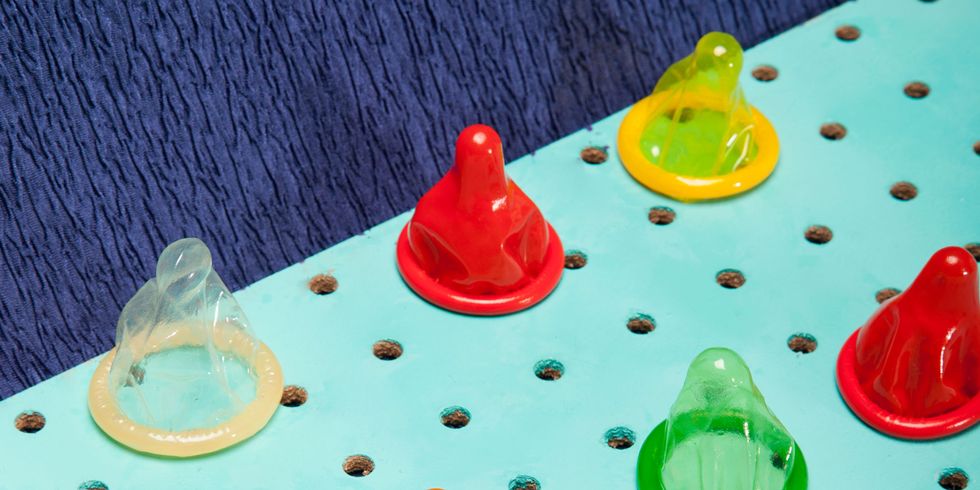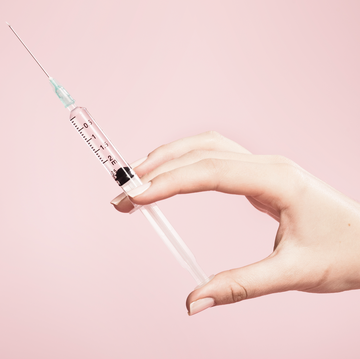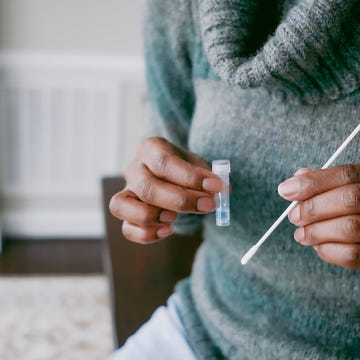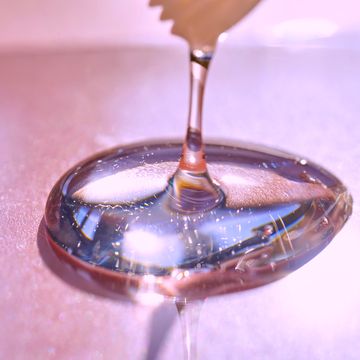When it comes to STDs and STIs, it doesn’t matter how many times you’ve had sex, who you have sex with, or how many partners you’ve had; anyone can get one. Whether you're having penetrative penis-in-vagina sex, or oral sex with someone of any gender and anatomy, you may be at risk of sexually transmitted infections. So always make sure you use condoms or dental dams, and remember if you're having sex with a penis-owning person, condoms are the only contraception that protect against both unwanted pregnancies and STIs.
Protecting yourself is important, because as sexual health experts and charity Brook say: STIs don’t always have noticeable symptoms. After having unprotected sex, it can be easy to be in denial and just hope you’ll be OK. But you should always get yourself tested as soon as possible so that you don’t pass anything on, or cause yourself (or a partner) long-term harm. "It's really common to feel nervous or embarrassed at the thought of getting tested but don’t worry, most infections are easily treated," Brook specialists say.
To educate yourself about the visible symptoms and signs, here they are. If you are experiencing any of these symptoms, you can visit Brook's online service for advice.
Chlamydia
Annoyingly, chlamydia is known as the "silent" infection because for 75% of women and people with vaginas, and 50% of men and people with penises, there are no obvious symptoms. This absolutely does not mean it's harmless or can go untreated though - it can eventually spread to other parts of the body causing pain and infertility. It can also infect your anus or throat.
If you do have symptoms, they can take a couple of weeks after coming into contact with the infection to appear. Look out for:
- Unusual discharge from the vagina, penis or rectum
- Burning and itching in the genital area if you're male
- Pain when peeing
- Heavy periods or bleeding between periods
- Pelvic and lower abdominal pain
- Abdominal pain in women during vaginal sex
- Bleeding during or after sex
- Painful swelling of testicles
Gonorrhoea
The second most common is gonorrhoea, which is a bacterial infection. Like chlamydia, it can make both men and women infertile. Half of women and people with vaginas won't notice any symptoms, but for those who do, they are:
- Yellow or green discharge
- A burning feeling when peeing
- Pain or tenderness in the stomach
- Heavy periods or bleeding between periods
- Painful swelling of the foreskin
- Pain or tenderness in the testicles
Genital herpes
Genital herpes is high contagious as it spreads super easily. After treatment, the virus still remains in your body and you can experience outbreaks later on. So while it's treatable, there is no cure. If you do have genital herpes, the first outbreak can last between two and four weeks.
The sores should heal within 5 to 10 days and will scab over. They shouldn't leave a scar. Any following outbreaks are usuallY much less severe. Symptoms include:
- Flu like symptoms such as fever, headache, aches and pains
- Stinging, tingling or itching in the genital or anal area
- Small fluid-filled blisters appear anywhere in the genital or anal area as well as the buttocks or tops of the thighs –
- these burst leaving small, red sores which can be very painful
- Pain when passing urine – due to the urine passing over the sores
- Vaginal or urethral discharge
HIV
Most commonly passed on through vaginal or anal sex, the HIV virus attacks the body's immune system which leaves it unable to fight off infections. It can be passed on through blood, semen and vaginal fluids. AIDS is often known as 'late stage HIV' and is basically the infection in its final stages, meaning the body isn't able to fight off life-threatening infections. If diagnosed early and treated, most people will not develop AIDS.
Around 80% of people with HIV will experience a two-week illness shortly after contracting it. This is seroconversion - the body produces antibodies to fight off the HIV, and it's these antibodies that an HIV test detects. Symptoms include:
- Weight loss
- Persistent diarrhoea
- Night sweats
- Infections that keep returning
- Serious life-threatening illnesses
Syphilis
Although syphilis is less common than the other STIs, the number of cases is increasing. It will develop in three stages and the third stage syphilis is rare in the UK. If it's treated early it can be cured. Look out for:
Stage one: primary syphilis (symptoms appear 2 to 4 weeks later)
- Small painless sore called a chancre, usually where the infection entered the body (genitals).
- Sometimes it can appear on lips, tonsils, hands or buttocks. It could disappear after 2 to 6 weeks.
Stage two: secondary syphilis (a few weeks after the sore heals)
- A non-itchy rash probably on the palms or soles of your feet
- Flat, small growths similar to warts near the vagina or anus
- Flu-like symptoms: headaches, fever, joint pains and tiredness
- Swollen glands in your neck, armpits or groin
- Weight loss
- White patches on your tongue or roof of your mouth
- Hair loss in patches
Once these symptoms have disappeared, you move into the latent phase which can last for years. If syphilis goes untreated it'll enter its third and most dangerous stage.
Pubic lice or "crabs"
Not technically an STI, but public lice (aka the crab-like minuscule insects that live in pubic hair) are passed on through close body contact. They can also live in armpit, leg, facial or back hair. They can also be passed from person to person by sharing towels or bedding. Symptoms to look out for:
- Noticing tiny (2mm) lice, six-legged, with two larger, claw-like legs
- The eggs are attached to the base of the hairs and pale brown
- The empty egg sacs are white
- Itching
- Black powder in your underwear which is the lice droppings
- Irritation and inflammation
- Sky-blue spots or very tiny specks of blood on the skin
Bacterial vaginosis
While BV, which BTW is the most common cause of vaginal discharge, isn't an STI, it IS something that's much more prevalent in sexually active women. Although half of women and people with vaginas won't notice anything, the other half will experience fishy, white discharge. It can also be grey or watery. If left untreated it can be pose a serious risk of miscarriage during pregnancy.
Hepatitis
There are different forms of hepatitis, but it's the viral kind that's sexually transmitted (B). it is, essentially, inflammation of the liver. It can be passed On through contact with infected blood, semen or vaginal fluids. There's no specific treatment and it usually disappears after a few months, but it can sometimes led to chronic hepatitis B.
Again, it's symptomless for most people. But early warning signs include include flu-like symptoms, feeling sick, and jaundice.
Genital warts
These tiny bumps/ growths will appear around your vagina or anus, and are caused by human papilloma virus (HPV). But, not everyone with the virus will have warts. They're spread by skin-to-skin contact and although they don't look great, they are normally painless.
Other places they can appear include:
- Around the cervix
- Inside the vagina
- Inside the anus
- On the penis (anywhere)
- Upper thighs
- Inside the male urethra
- On the scrotum
Cystitis
You got me, this is not an STI at all. But it's so so common in women and people with vaginas (it does happen to men and penis-havers too) and more often than not, it happens post-sex. Also it is THE DEVIL. Symptoms include:
- A desperate and frequent urge to wee - but only small amounts come out
- Pain, burning or stinging when you wee
- Pain in directly above your pubic area, lower back or abdomen
- Wee that is dark, cloudy or smelly
- Traces of blood when you wee
- Feeling unwell, weak or feverish (hot and cold)



